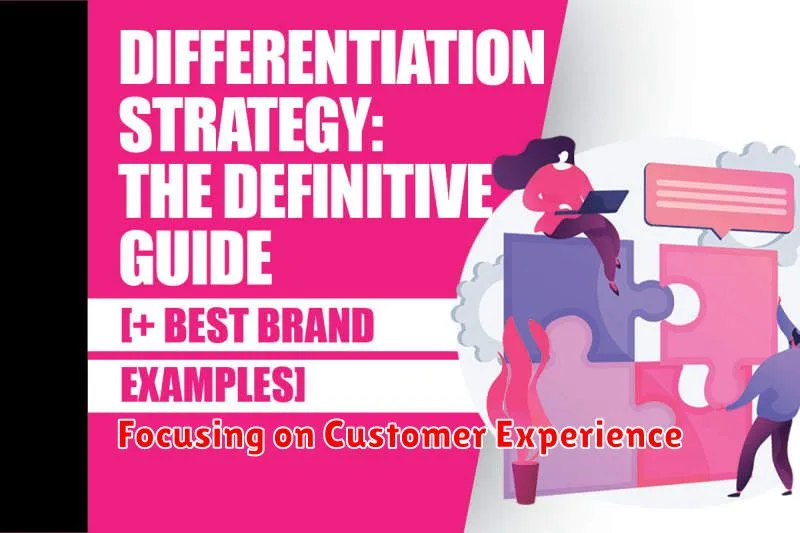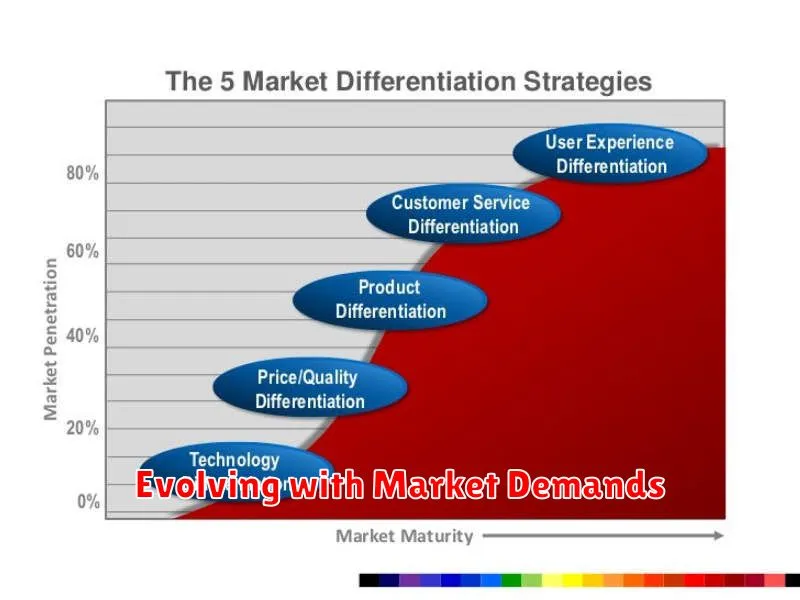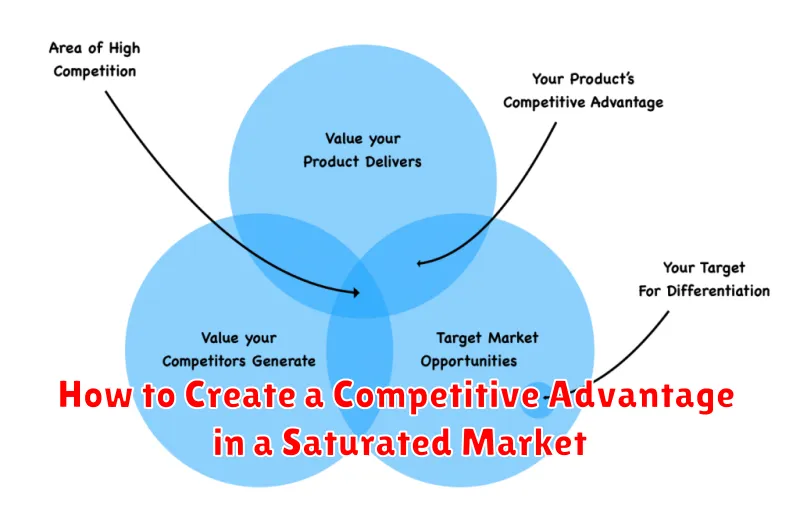Navigating a saturated market can feel like traversing a dense jungle. Competition is fierce, customers are bombarded with choices, and carving out a distinct space for your business becomes a paramount challenge. Developing a competitive advantage is no longer a luxury, but a necessity for survival. This article will delve into proven strategies and actionable insights to help you not only survive but thrive in a saturated market, establishing a competitive edge that sets you apart and attracts customers.
Building a competitive advantage requires a keen understanding of your market, your target audience, and your own unique strengths. From innovative product differentiation and superior customer service to streamlined operations and strategic pricing, there are numerous avenues to explore. Discover how to identify your key differentiators, cultivate competitive advantages that resonate with your target market, and ultimately dominate a saturated market with a compelling value proposition.
Identifying Your Unique Value Proposition
In a saturated market, a strong value proposition is crucial. It’s the key to differentiating your offerings from the competition and attracting customers. This involves clearly understanding what makes your product or service distinctly valuable.
Start by analyzing your target audience. What are their pain points? What solutions do they seek? Then, carefully consider your competitors. What are their strengths and weaknesses? Where are the gaps in the market?
Your unique value proposition should succinctly articulate the specific benefits customers gain by choosing you over alternatives. This could be superior quality, innovative features, exceptional customer service, or a more competitive price. Be precise and avoid generic claims.
Analyzing Competitor Strengths and Weaknesses
Understanding your competition is crucial for developing a competitive advantage. A thorough analysis reveals opportunities to differentiate your offering and capitalize on market gaps.
Start by identifying your key competitors. Analyze their strengths, such as pricing, marketing strategies, customer service, and product features. Equally important is identifying their weaknesses. Are there areas where they underperform? Do they have negative customer reviews regarding specific aspects of their business?
Use a SWOT analysis (Strengths, Weaknesses, Opportunities, and Threats) framework to organize your findings. This allows for a clear, structured overview, facilitating strategic decision-making.
Focusing on Customer Experience

In a saturated market, a superior customer experience can be a powerful differentiator. Customer-centric businesses prioritize understanding and exceeding customer expectations. This involves every touchpoint, from initial contact to post-sale support.
By focusing on providing personalized experiences, businesses can foster strong customer loyalty and advocacy. This can lead to increased customer lifetime value and a sustainable competitive advantage.
Key areas to focus on include:
- Proactive customer service: Anticipating customer needs and resolving issues before they escalate.
- Streamlined processes: Making it easy for customers to interact with your business.
- Personalized communication: Tailoring messages and offers to individual customer preferences.
Using Innovation as a Differentiator
In a saturated market, innovation serves as a powerful tool to distinguish your offerings from competitors. It allows you to capture customer attention and establish a unique value proposition. Innovation doesn’t necessarily require groundbreaking inventions; incremental improvements can be just as effective.
Consider focusing on three key areas: product innovation, process innovation, and marketing innovation. Product innovation involves enhancing existing products or developing entirely new ones. Process innovation streamlines operations, leading to cost savings and improved efficiency. Marketing innovation explores novel approaches to reach and engage customers.
By strategically implementing innovation across these areas, businesses can cultivate a distinct competitive advantage and thrive even in the most crowded markets.
Developing Brand Loyalty
In a saturated market, brand loyalty is a powerful competitive advantage. It creates a consistent customer base and reduces reliance on attracting new customers, which can be costly and challenging. Loyal customers are more likely to choose your brand over competitors, even in the face of competitive pricing or marketing efforts.
Building brand loyalty requires a customer-centric approach. Focus on delivering exceptional customer service, offering high-quality products or services, and creating a positive brand experience at every touchpoint. Consistency in these areas builds trust and fosters a strong emotional connection between the customer and your brand.
Pricing Strategies for Competitive Markets
In a saturated market, pricing becomes a crucial element of competitive strategy. Businesses must carefully consider their costs, customer perceived value, and competitor pricing to develop an effective pricing strategy.
Cost-plus pricing involves adding a markup to the cost of production. While simple, it doesn’t account for market dynamics.
Value-based pricing focuses on the perceived value offered to the customer. This strategy can command higher prices if the value proposition is strong.
Competitive pricing involves setting prices similar to competitors. This strategy is common in commodity markets but can lead to price wars.
Premium pricing sets higher prices than competitors, emphasizing superior quality or features. This strategy requires a strong brand and differentiated product.
Choosing the right pricing strategy requires a deep understanding of your target market and competitive landscape. Careful analysis and monitoring are essential for success.
Operational Efficiency and Optimization
In a saturated market, operational efficiency can be a significant differentiator. Streamlining processes and reducing operational costs allows businesses to offer competitive pricing or reinvest savings into other areas like marketing or research and development. This can translate to increased profit margins and a stronger market position.
Optimizing your supply chain, from procurement to delivery, is crucial. This involves identifying and eliminating bottlenecks, improving inventory management, and negotiating favorable terms with suppliers. Automation of repetitive tasks can also greatly improve efficiency and free up human resources for more strategic initiatives.
Leveraging Partnerships and Alliances
In a saturated market, strategic partnerships and alliances can be a powerful tool for differentiation. Collaborating with complementary businesses expands your reach and resources, offering access to new customer bases and specialized expertise. Synergistic partnerships amplify your value proposition by bundling offerings or integrating solutions.
For example, a software company could partner with a hardware provider to deliver a complete solution. This not only increases market penetration but also enhances the customer experience by offering a seamless, integrated product.
Carefully consider the strategic fit of potential partners. Aligning with businesses that share your values and target a similar customer demographic ensures a cohesive and impactful partnership.
Creating Barriers to Entry
In a saturated market, establishing barriers to entry is crucial for maintaining a competitive advantage. These barriers discourage new competitors from entering the market, giving existing businesses more breathing room. Several strategies can be employed to achieve this.
High capital requirements can deter new entrants. Significant upfront investments in specialized equipment or infrastructure make it challenging for smaller or less established businesses to compete.
Proprietary technology or intellectual property, such as patents and trade secrets, can provide a distinct advantage and create a legal barrier for competitors.
Strong brand recognition and customer loyalty are powerful deterrents. Established brands benefit from consumer trust, making it harder for newcomers to gain market share.
Exclusive access to resources or distribution channels can effectively shut out competition. Securing favorable contracts or controlling essential suppliers limits the options available to potential rivals.
Evolving with Market Demands

In a saturated market, standing still equates to falling behind. Adaptability is key to maintaining a competitive advantage. Continuously monitoring and analyzing market trends enables businesses to anticipate shifts in consumer preferences and proactively adjust their offerings.
This involves actively seeking customer feedback, conducting market research, and staying informed about competitor activities. By understanding evolving demands, businesses can innovate and adapt, ensuring their products and services remain relevant and desirable.
This might involve introducing new features, streamlining processes, or even pivoting to a new business model entirely. The ability to evolve is a crucial element of long-term success in a competitive landscape.

